Attached files
| file | filename |
|---|---|
| EX-99.1 - EX-99.1 - ACI WORLDWIDE, INC. | d493537dex991.htm |
| 8-K - FORM 8-K - ACI WORLDWIDE, INC. | d493537d8k.htm |

| December 31, 2012 Quarterly and Year End Results Presentation February 28, 2013 ACI's software underpins electronic payments throughout retail and wholesale banking, and commerce all the time. Exhibit 99.2 |
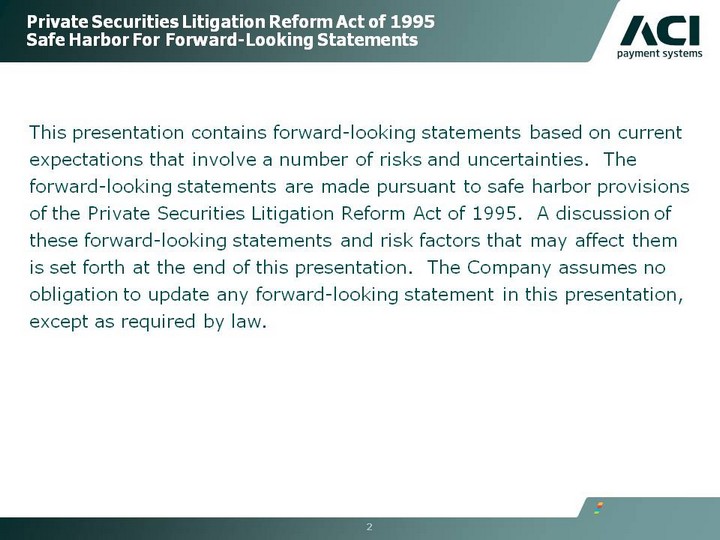
| 2 Private Securities Litigation Reform Act of 1995 Safe Harbor For Forward-Looking Statements This presentation contains forward-looking statements based on current expectations that involve a number of risks and uncertainties. The forward-looking statements are made pursuant to safe harbor provisions of the Private Securities Litigation Reform Act of 1995. A discussion of these forward-looking statements and risk factors that may affect them is set forth at the end of this presentation. The Company assumes no obligation to update any forward-looking statement in this presentation, except as required by law. |

| Annual Overview Phil Heasley Chief Executive Officer |

| 2012 Year in Review 4 Closed S1 acquisition in Q1 and removed $48 million of cost from combined business Integration substantially complete Acquired Distra Provides key IP that drives the innovative Universal Payments Platform strategy that transforms how payment services are taken to market and how customers will use them to their competitive advantage Repurchased 1.4 million shares for approximately $58 million Finished year with strong Q4 Strong revenue growth driven by project completions converting revenue from backlog Strong growth in operating income and adjusted EBITDA Sales bookings up 81% over prior year quarter, up 61% sequentially over Q3 Sales bookings and strong pipeline providing forward momentum into 2013 Resolved potential dilution from IBM warrants through settlement Repurchased warrants exercisable for 2.5 million shares Announced the acquisition of Online Resources Corporation Expect to close in Q1 2013 |
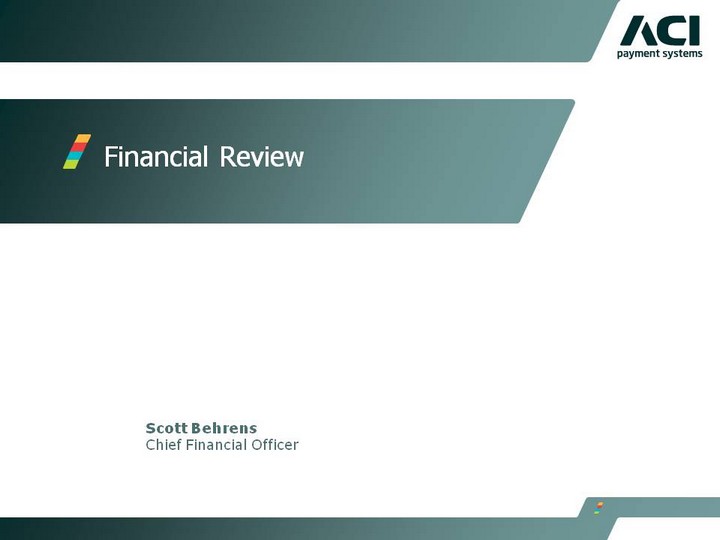
| Financial Review Scott Behrens Chief Financial Officer |

| 6 Key Takeaways from the Quarter Strong Q4 Sales Bookings Strong sales growth, up $138 million or 81% over prior year quarter, up 61% sequentially Historical ACI sales and sales net of term extensions up 33% and 9%, respectively over prior year quarter S1 Acquisition contributed approximately $80.8 million of sales to the quarter Sales, net of term extensions, increased $81 million or 69% over prior year quarter Solid Backlog Growth led by Strong Sales 60-month backlog growth of $49 million 12-month backlog growth of $12 million Strong Revenue Quarter Strong growth in Historical ACI revenue, up $40.7 million or 30% S1 contributed $48.4 million in revenue for the quarter Q4 GAAP revenue impacted by $3.6 million of deferred revenue haircut Operating Expense S1 contributed $42.7 million in expenses for the period Historical ACI expenses higher compared to prior year quarter primarily from higher deferred cost recognition from project go-lives $4.4 million of one-time S1 related integration expenses Non-GAAP Operating Income & Adjusted EBITDA Non-GAAP Operating Income increased $43.4 million or 108% over prior year quarter Non-GAAP Adjusted EBITDA increased $49.2 million or 95% over prior year quarter |

| Key Takeaways from the Year Strong Revenue Growth Strong growth in Historical ACI revenue, up $39.6 million or 8.5% S1 contributed $161.9 million in revenue for the year Full year GAAP revenue impacted by $22.5 million of deferred revenue haircut Operating Expense S1 contributed $159.0 million in expenses for the period Historical ACI expenses higher primarily from higher deferred cost recognition from project go-lives $31.5 million of one-time S1 related acquisition and integration expenses Non-GAAP Operating Income & Adjusted EBITDA Non-GAAP Operating Income increased $55.4 million or 76% over prior year Non-GAAP Adjusted EBITDA increased $78.9 million or 70% over prior year Debt & Liquidity Ended the year with $76.3 million in cash Repaid $20.7 million refundable liability to IBM upon termination of Alliance in December 2012 Full year operating free cash flow impacted primarily by back-end timing of sales bookings and revenue during the year and corresponding increase in receivables Ended year with $176.3 million of accounts receivable representing 75 days revenue outstanding (vs. 62 days revenue outstanding at the end of the prior year) As of December 31, 2012, debt outstanding of $374.3 million Remaining repurchase authorization now 1.8 million shares 7 |

| 8 2013 Outlook Sales, net of term extension, growth in the high single digits to low double digits Revenue growth in mid to high single digits Revenue and margin phasing by quarter consistent with 2012 Operating Income margin of 20% Adjusted EBITDA margin of 30% Depreciation and amortization expected to approximate $64 million Non-cash compensation expense expected to approximate $15 million Diluted Share Count to approximate 40 million (excluding future share buy-back activity) ($ in Millions) |

| 9 ACI / ORCC - Transaction Update Tender offer initiated on Friday, February 8th Tender offer remains open for 20 business days ORCC's Board of Directors unanimously approved the transaction and recommend shareholders to tender their shares ORCC's largest shareholder and its CEO (combined ~22% ownership) have entered into support agreements to tender shares Received regulatory HSR approval ahead of schedule Anticipated closing the transaction in mid-March 2013 Integration planning in process Annual cost synergies of $19.5 million to be actioned within 60 days of close Additional cost synergies, including data center and facilities consolidation, to be provided at a later date Status and progress of the ORCC integration will be updated quarterly |

| Appendix |

| 11 Historic Sales By Quarter 2010-2012 |
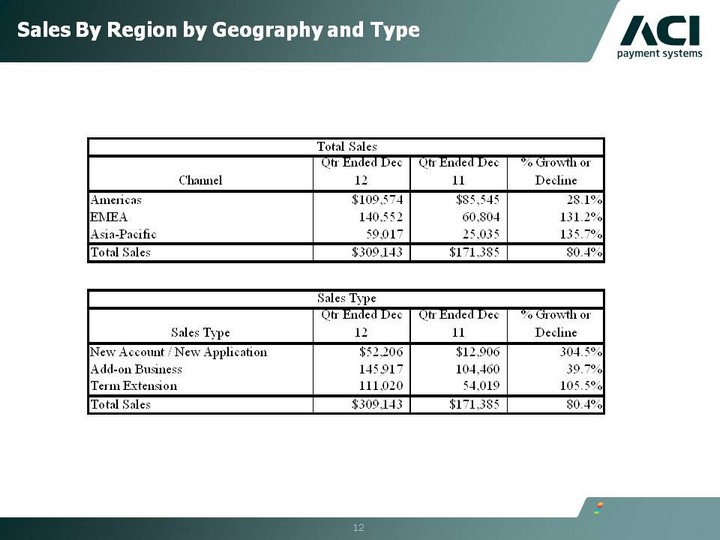
| Sales By Region by Geography and Type 12 |

| Backlog as a Contributor of Quarterly Revenue Backlog from monthly recurring revenues and project go-lives continues to drive current quarter GAAP revenue Revenue from current quarter sales consistent with prior quarters 13 |
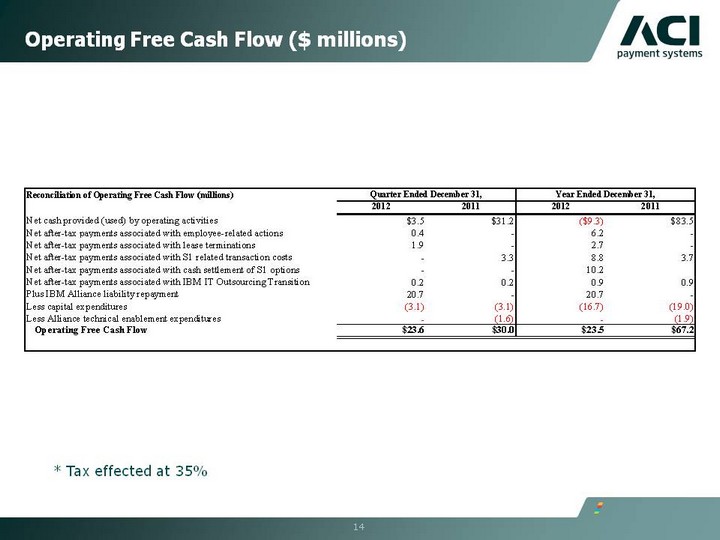
| Operating Free Cash Flow ($ millions) 14 * Tax effected at 35% |

| 60-Month Backlog ($ millions) 15 |

| Revenues by Channel ($ millions) 16 |
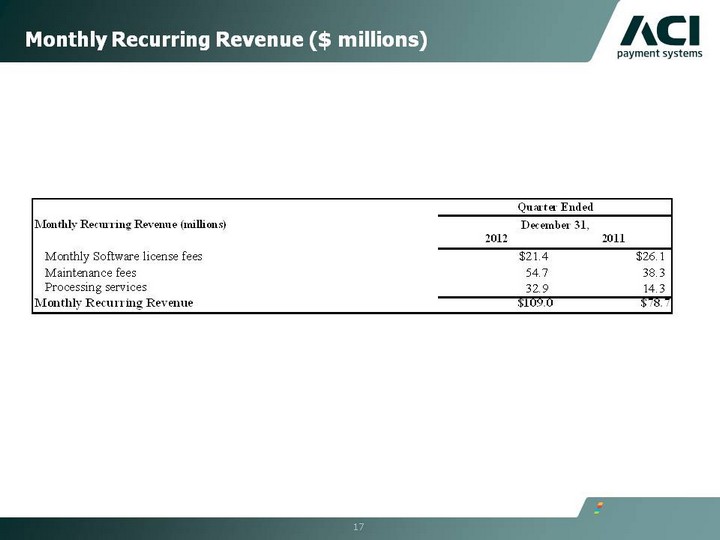
| Monthly Recurring Revenue ($ millions) 17 |

| Deferred Revenue and Expense ($ millions) 18 |

| Non-Cash Compensation, Acquisition Intangibles and Software, and Acquisition-Related Expenses 19 |
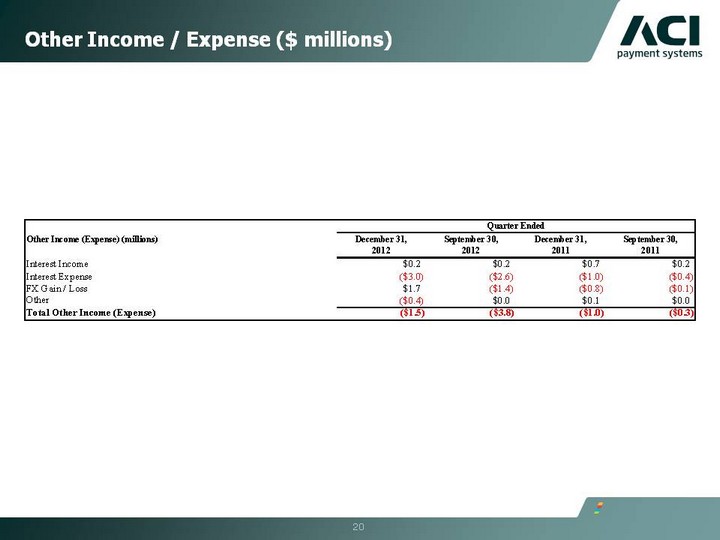
| Other Income / Expense ($ millions) 20 |
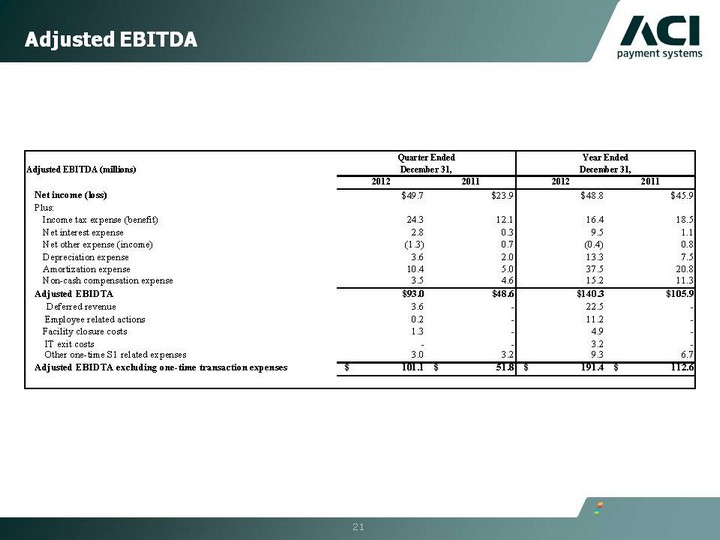
| Adjusted EBITDA 21 |
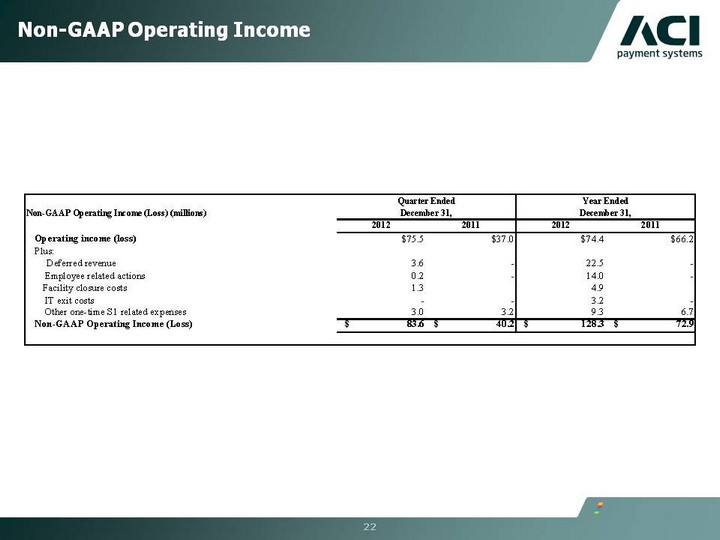
| Non-GAAP Operating Income 22 |

| Non-GAAP Financial Measures To supplement our financial results presented on a GAAP basis, we use the non-GAAP measure indicated in the tables, which exclude certain business combination accounting entries and expenses related to the acquisition of S1, as well as other significant non-cash expenses such as depreciation, amortization and share-based compensation, that we believe are helpful in understanding our past financial performance and our future results. The presentation of these non-GAAP financial measures should be considered in addition to our GAAP results and are not intended to be considered in isolation or as a substitute for the financial information prepared and presented in accordance with GAAP. Management generally compensates for limitations in the use of non-GAAP financial measures by relying on comparable GAAP financial measures and providing investors with a reconciliation of non-GAAP financial measures only in addition to and in conjunction with results presented in accordance with GAAP. We believe that these non-GAAP financial measures reflect an additional way of viewing aspects of our operations that, when viewed with our GAAP results, provide a more complete understanding of factors and trends affecting our business. Certain non- GAAP measures include: Non-GAAP revenue: revenue plus deferred revenue that would have been recognized in the normal course of business by S1 if not for GAAP purchase accounting requirements. Non-GAAP revenue should be considered in addition to, rather than as a substitute for, revenue. Non-GAAP operating income: operating income (loss) plus deferred revenue that would have been recognized in the normal course of business by S1 if not for GAAP purchase accounting requirements and one-time expense related to the acquisition of S1. Non-GAAP operating income should be considered in addition to, rather than as a substitute for, operating income. Adjusted EBITDA: net income (loss) plus income tax expense, net interest income (expense), net other income (expense), depreciation, amortization and non-cash compensation, as well as deferred revenue that would have been recognized in the normal course of business by S1 if not for GAAP purchase accounting requirements and one-time expense related to the acquisition of S1. Adjusted EBITDA should be considered in addition to, rather than as a substitute for, operating income. 23 |

| Non-GAAP Financial Measures ACI is also presenting operating free cash flow, which is defined as net cash provided by operating activities, plus net after-tax payments associated with employee-related actions and facility disclosures, net after-tax payments associated with IBM IT outsourcing transition, and less capital expenditures. Operating free cash flow is considered a non-GAAP financial measure as defined by SEC Regulation G. We utilize this non-GAAP financial measure, and believe it is useful to investors, as an indicator of cash flow available for debt repayment and other investing activities, such as capital investments and acquisitions. We utilize operating free cash flow as a further indicator of operating performance and for planning investing activities. Operating free cash flow should be considered in addition to, rather than as a substitute for, net cash provided by operating activities. A limitation of operating free cash flow is that it does not represent the total increase or decrease in the cash balance for the period. This measure also does not exclude mandatory debt service obligations and, therefore, does not represent the residual cash flow available for discretionary expenditures. We believe that operating free cash flow is useful to investors to provide disclosures of our operating results on the same basis as that used by our management. ACI also includes backlog estimates, which include all software license fees, maintenance fees and services specified in executed contracts, as well as revenues from assumed contract renewals to the extent that we believe recognition of the related revenue will occur within the corresponding backlog period. We have historically included assumed renewals in backlog estimates based upon automatic renewal provisions in the executed contract and our historic experience with customer renewal rates. 24 |

| Non-GAAP Financial Measures Backlog is considered a non-GAAP financial measure as defined by SEC Regulation G. Our 60-month backlog estimate represents expected revenues from existing customers using the following key assumptions: Maintenance fees are assumed to exist for the duration of the license term for those contracts in which the committed maintenance term is less than the committed license term. License and facilities management arrangements are assumed to renew at the end of their committed term at a rate consistent with our historical experiences. Non-recurring license arrangements are assumed to renew as recurring revenue streams. Foreign currency exchange rates are assumed to remain constant over the 60-month backlog period for those contracts stated in currencies other than the U.S. dollar. Our pricing policies and practices are assumed to remain constant over the 60-month backlog period. Estimates of future financial results are inherently unreliable. Our backlog estimates require substantial judgment and are based on a number of assumptions as described above. These assumptions may turn out to be inaccurate or wrong, including for reasons outside of management's control. For example, our customers may attempt to renegotiate or terminate their contracts for a number of reasons, including mergers, changes in their financial condition, or general changes in economic conditions in the customer's industry or geographic location, or we may experience delays in the development or delivery of products or services specified in customer contracts which may cause the actual renewal rates and amounts to differ from historical experiences. Changes in foreign currency exchange rates may also impact the amount of revenue actually recognized in future periods. Accordingly, there can be no assurance that contracts included in backlog estimates will actually generate the specified revenues or that the actual revenues will be generated within the corresponding 60-month period. Backlog should be considered in addition to, rather than as a substitute for, reported revenue and deferred revenue. 25 |

| Forward-Looking Statements This presentation contains forward-looking statements based on current expectations that involve a number of risks and uncertainties. Generally, forward-looking statements do not relate strictly to historical or current facts and may include words or phrases such as "believes," " will," "expects," "anticipates," "intends," and words and phrases of similar impact. The forward-looking statements are made pursuant to safe harbor provisions of the Private Securities Litigation Reform Act of 1995. Forward-looking statements in this presentation include, but are not limited to, statements regarding: • expectations that our growth objectives will accelerate in 2013 partly as a result of the substantial completion of the S1 integration; expectations that the addition of Online Resources' electronic bill payment platform (through our pending acquisition of Online Resources Corporation) will enable us to be recognized as the "universal payments platform company"; and expectations regarding 2013 financial guidance related to revenue, operating income and adjusted EBITDA. 26 |

| Forward-Looking Statements All of the foregoing forward-looking statements are expressly qualified by the risk factors discussed in our filings with the Securities and Exchange Commission. Such factors include but are not limited to, increased competition, the performance of our strategic product, BASE24-eps, demand for our products, restrictions and other financial covenants in our credit facility, consolidations and failures in the financial services industry, customer reluctance to switch to a new vendor, the accuracy of management's backlog estimates, the maturity of certain products, our strategy to migrate customers to our next generation products, ratable or deferred recognition of certain revenue associated with customer migrations and the maturity of certain of our products, failure to obtain renewals of customer contracts or to obtain such renewals on favorable terms, delay or cancellation of customer projects or inaccurate project completion estimates, volatility and disruption of the capital and credit markets and adverse changes in the global economy, our existing levels of debt, impairment of our goodwill or intangible assets, litigation, future acquisitions, strategic partnerships and investments, risks related to the expected benefits to be achieved in the proposed transaction with Online Resources, the complexity of our products and services and the risk that they may contain hidden defects or be subjected to security breaches or viruses, compliance of our products with applicable legislation, governmental regulations and industry standards, our compliance with privacy regulations, the protection of our intellectual property in intellectual property litigation, the cyclical nature of our revenue and earnings and the accuracy of forecasts due to the concentration of revenue generating activity during the final weeks of each quarter, business interruptions or failure of our information technology and communication systems, our offshore software development activities, risks from operating internationally, including fluctuations in currency exchange rates, exposure to unknown tax liabilities, and volatility in our stock price. For a detailed discussion of these risk factors, parties that are relying on the forward-looking statements should review our filings with the Securities and Exchange Commission, including our most recently filed Annual Report on Form 10-K, Registration Statement on Form S-4, and subsequent reports on Forms 10-Q and 8-K. 27 |

| ACI's software underpins electronic payments throughout retail and wholesale banking, and commerce all the time, without fail. www.aciworldwide.com |
